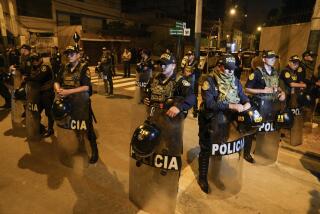Security System Installed at Forbidden City : Burglars Pillage China’s Art Treasures
- Share via
PEKING — China’s anti-crime drive has reached beyond the moat of Peking’s ancient Forbidden City with the installation of sophisticated security devices to protect the treasures of the country’s rich Imperial past.
Since the Communist takeover in 1949, three burglars, one a Kung Fu expert, have managed to grab items from the vast former home of Chinese emperors, now a museum housing 200,000 precious relics from pre-revolutionary days.
All three were eventually caught and one was executed but, as the China Daily reports, the museum is taking no chances. A spokesman quoted by the paper said exhibits are now guarded by ultra-modern security systems, supposedly making the Forbidden City burglar-proof.
Crime Wave
Judging by widespread thefts of antiquities reported during a recent nationwide crime wave, there is no lack of people in China prepared to take risks to pillage valuable art treasures.
Since 1982, Western dealers have been astonished at the sudden flood of Chinese antiquities appearing on international markets--apparently dug up by tomb robbers and smuggled out via Hong Kong.
In September, residents of Shanghai pulled the legs, arms, ears and legs off a 200-year-old corpse uncovered by workmen in a scramble to get at the Qing dynasty jewelry she wore.
A spokesman for the Palace Museum, as the Forbidden City is officially known, made clear that such things are not about to happen here.
“Any attempt to steal cultural relics from the museum is doomed to fail,” he said, adding that severe punishments awaited anyone foolhardy enough to try.
In 1959 a burglar called Wu Qinghui sneaked into one exhibition room of the palace, which was reserved until the mid-1920s for members of the royal family, their concubines and eunuchs.
Jailed for Life
Wu got away with eight gold articles, five knives from the Qing dynasty (1644-1911) and an ancient gold coin. He was caught taking his loot to distant northwestern Xinjiang province and jailed for life.
A self-styled martial arts expert called Song Guofang was the next to try, on an April night in 1962, the paper said. Song almost got away with nine gold exhibits weighing 52 pounds but was grabbed vaulting a palace wall. He was tried and shot the same year.
In the third incident, a guard hit ex-convict Chen Yinhua with a brick as he tried to scale the wall of a secluded Imperial garden in 1980 carrying a great Imperial gold seal. Chen was jailed for life.
Policing the palace-city is hard because of its size--a rectangle 1,050 yards by 820 yards--and because tens of thousands of tourists daily throng its maze of cobbled courtyards and yellow-roofed halls and pavilions.
The great complex, erected in its present shape by 200,000 workmen under the Ming dynasty in the 15th Century, has built-in deterrents for would-be burglars, notably a moat 54 yards wide, walls 35 feet high and a succession of massive red-painted gates and fortifications designed to strike visitors with awe.
But only a fraction of the palace’s original riches remain. Most of the contents of this unique treasure house were taken not by burglars but by the retreating nationalists to Taiwan in 1949. They are now displayed in the National Palace Museum outside Taipei.
Careful Preservation
The Communist leadership has been careful to preserve the palace, a national symbol of China. It was from its southernmost gate, Tienanmen, that Mao Tse-tung proclaimed the People’s Republic on Oct. 1, 1949.
Even during Mao’s extreme-leftist 1966-76 Cultural Revolution, when fanatical Red Guards smashed such precious relics as the tomb of Confucius in Shandong province, the Imperial palace was placed under special guard and escaped largely unscathed.
More to Read
Sign up for Essential California
The most important California stories and recommendations in your inbox every morning.
You may occasionally receive promotional content from the Los Angeles Times.













